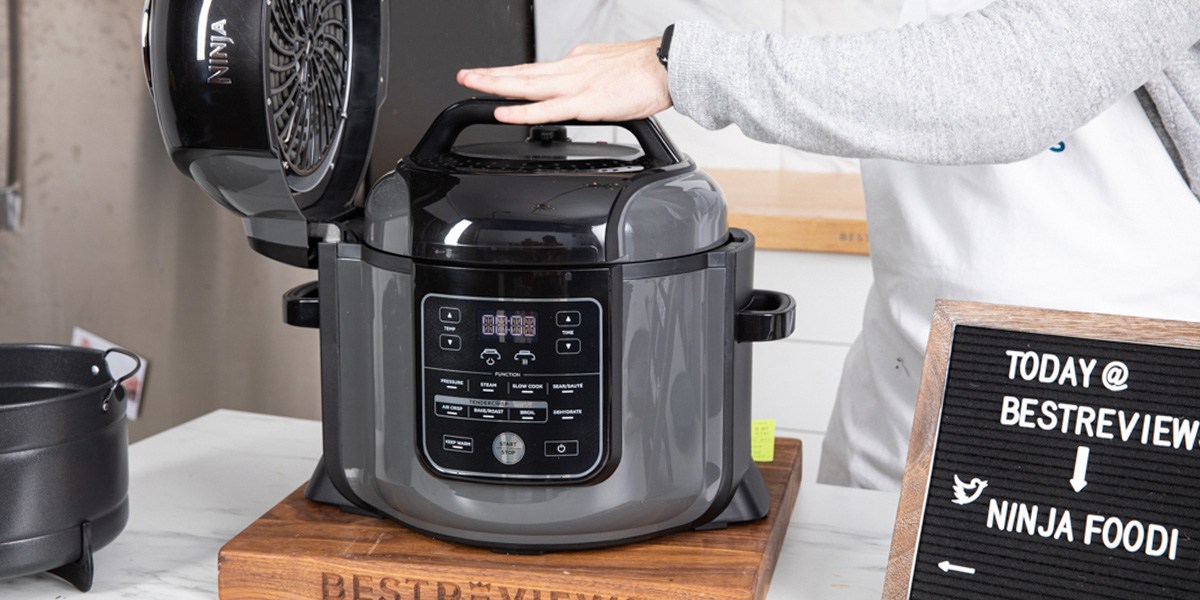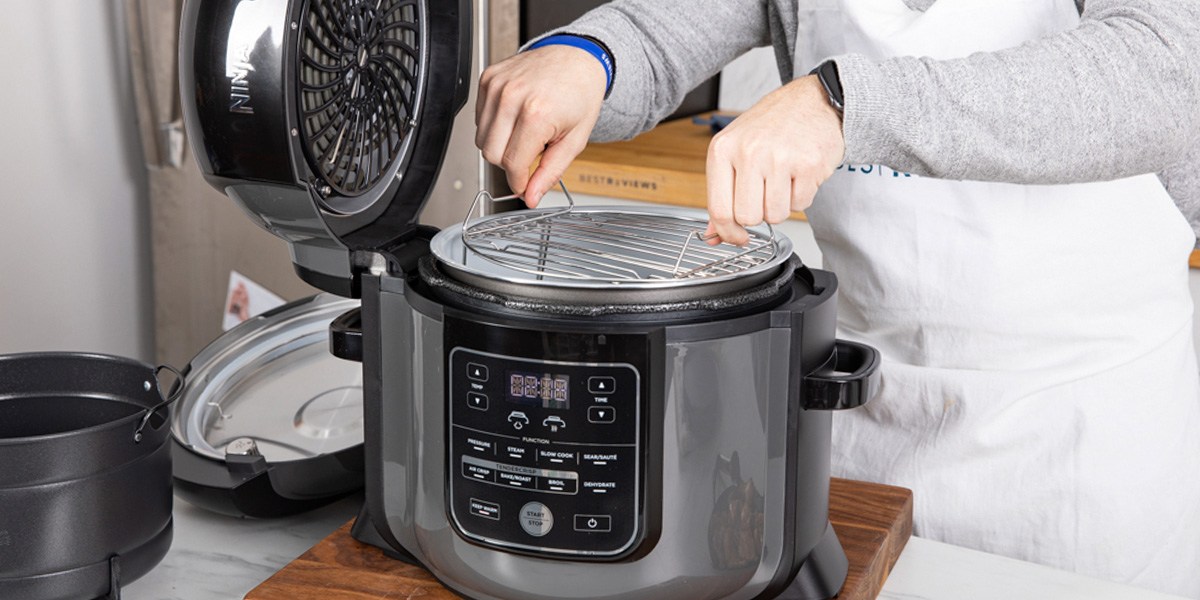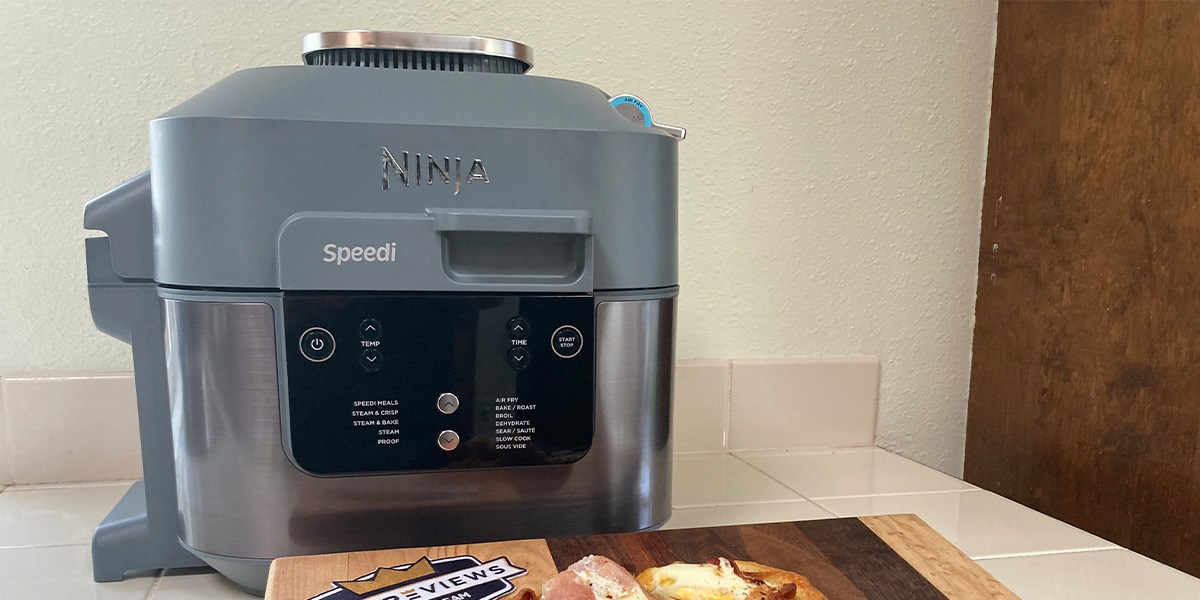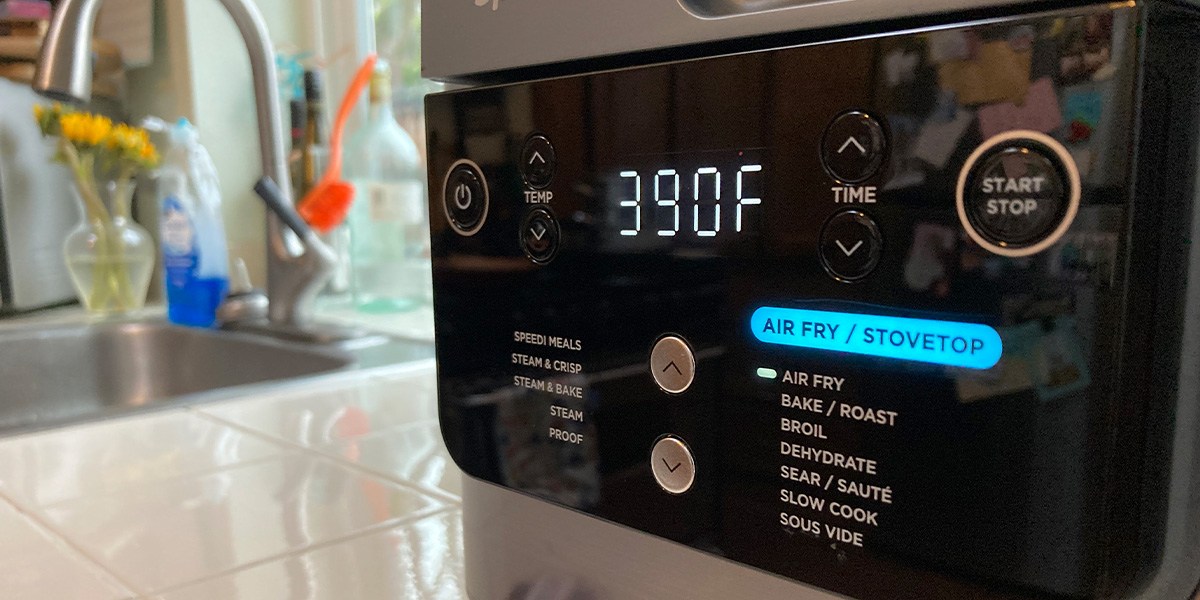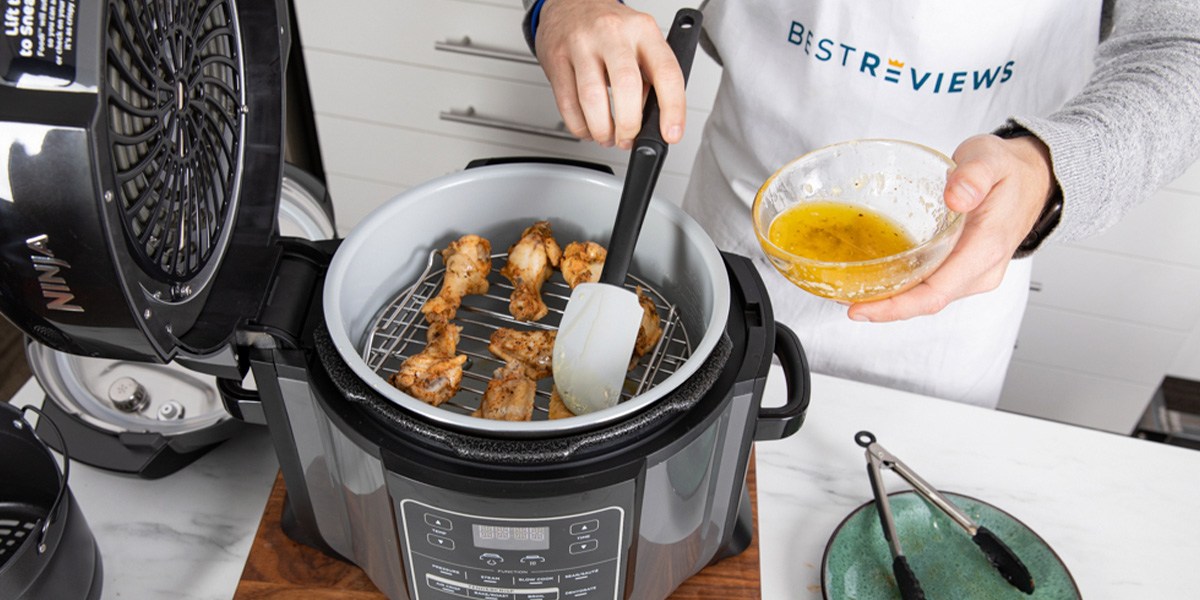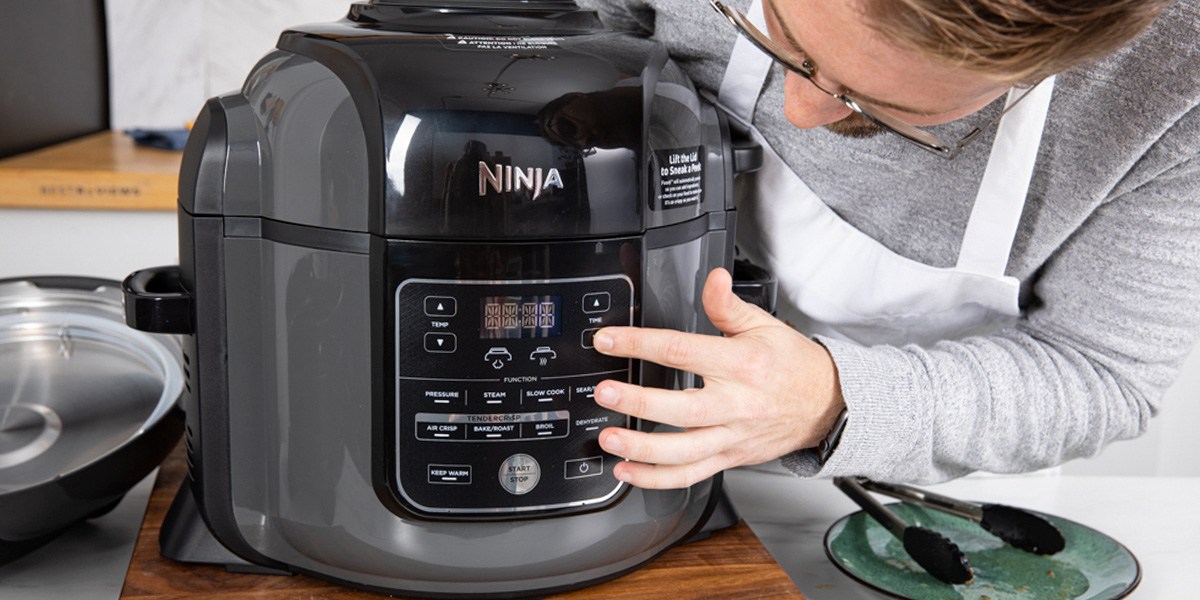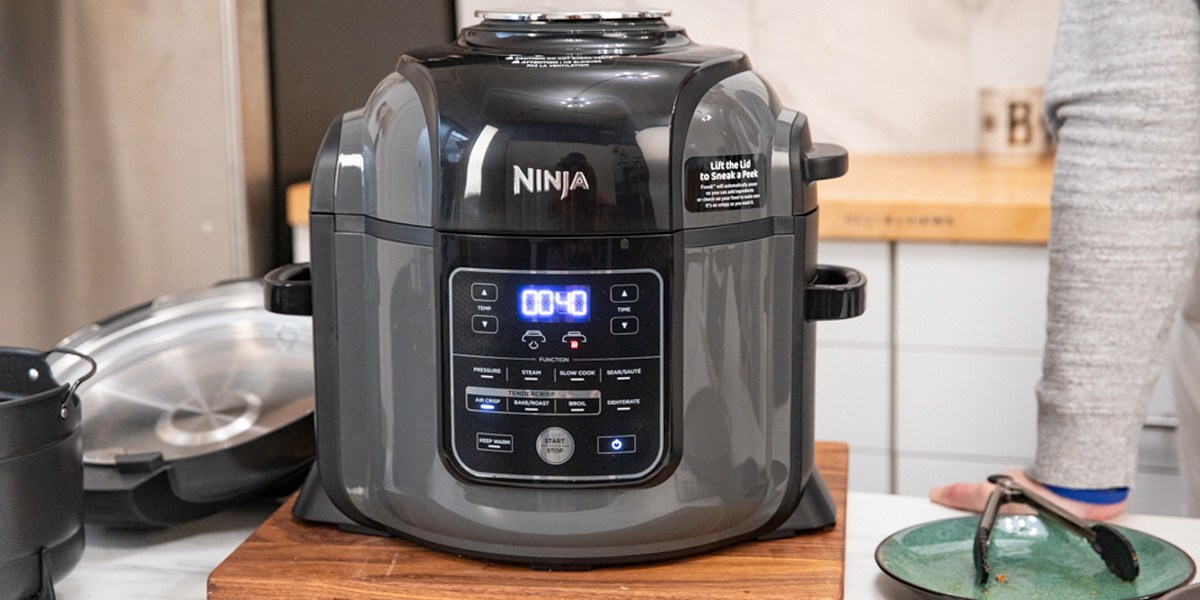We put them both to the test to see which is best for you
Ninja is well-known for its countertop multicookers that can get dinner on the table in a hurry. If you’re trying to decide between the Ninja Speedi and the Ninja Foodi, there are some key differences that set these popular models apart.
The Speedi, thanks to its Speedi Meals function, can steam and air-fry foods at the same time to create a complete meal for two in less than 30 minutes (imagine using just one 6-quart pot to make crispy chicken breasts, moist vegetables and rice at the same time). The Ninja Foodi, on the other hand, is an air fryer as well as a pressure cooker. Its larger 8-quart pot can whip up enough food to feed at least four hungry people in no time.
But those aren’t the only differences between these two highly rated products. In the BestReviews Testing Lab, we took a close look at both to break down their similarities and differences to help you decide which one is right for your needs.
What is the Ninja Foodi?
Testing Team sets up the Ninja Foodi to evaluate cooking functions, safety features and cooking times for various foods.
Product specifications
Type: Pressure cooker | Capacity: 8 qt | Dimensions: 14.57″ D x 16.1″ W x 14.2″ H | Weight: 26 lb | Material: Plastic and stainless steel | Control Type: Touch and dial | Number of Functions: 12 | Temperature Range: 80 to 400 degrees
The Ninja Foodi is a special appliance. It’s an all-in-one multicooker that let us prepare food just about any way we wanted. We could cook with dry heat or moist heat and speed up the process with pressure cooking. Although it took about 15 minutes for the Foodi to pressurize, we could still cook many foods in about a third of the time it took to make them in a conventional oven. Because all of these features were available in one unit, we were able to combine them to get the benefits of pressure cooking and air-frying in a single dish. Best of all, with the included attachments, this appliance could cook plenty of food for a family — eight chicken breasts at one time.
Ninja Foodi pros and cons
No-mess cooking and keeping food warm are some of the benefits offered by the Ninja Foodi.
As versatile as the Foodi is, everything wasn’t perfect. There are a few important aspects you’ll want to know before making a decision. Here are the pros and cons of the Ninja Foodi.
Pros
- Cooks food quickly: The pressure cooker function let us cook food in as little as one-third the time it took to prepare it using other methods.
- Offers an abundance of safety features: Besides the locking lid and pressure venting, this Ninja has nine other safety features to ensure nothing went wrong when we used it.
- Has 12 cooking functions: We could do everything from dehydrate to pressure cook with this versatile appliance.
- Set-it-and-forget-it cooking: When using the pressure-cooking function, we just put the food in, turned on the appliance and let it do its thing. We didn’t have to lift a finger until the dish was done.
- Kept our food warm: We could make a dish in the morning and keep it warm all day, so hot food was available whenever anyone in the family got hungry.
- Gave us no-mess cooking: Especially when using the pressure-cooking function, everything was contained in one pot with no possibility of boiling over or making any kind of mess while cooking.
Cons
- The hinged lid can be awkward: Having the crisper lid permanently attached made it impossible to use the Foodi under our cabinets — there wasn’t enough overhead clearance.
- Pressurizing took 15 minutes: While we saved a lot of time using the pressure-cooking feature, it did take about 15 minutes to pressurize. This increased the cooking time, making it closer to only half as fast, if the pressurizing time was included. However, this was still acceptable for our needs.
- Some recipes required a little learning: When the recipes required multiple steps, such as using the TenderCrisp technology, we had to consult the owner’s manual — operation wasn’t intuitive.
- Heavy: We could move the Foodi around, but some people might need help because it weighs 26 pounds.
- Couldn’t check food till the recipe finished cooking: If we were trying a new recipe, we could not check on the pressure-cooking progress. We had to wait until everything was done cooking to see if the food was cooked as expected.
What is the Ninja Speedi?
The Testing Team evaluates the Ninja Speedi’s cooking capabilities by trying out recipes for popular air-fried foods.
Product specifications
Type: Basket air fryer | Capacity: 6 qt | Dimensions: 14.1” L x 13.8” W x 12.4” H | Weight: 16 lb | Material: Plastic | Control Type: Push-button | Number of Functions: 12 | Temperature Range: 90 to 450 degrees
Like the Foodi, the Ninja Speedi is a versatile model that can cook food using both dry heat and moist heat. The primary difference is the Speedi does not have the ability to pressure cook. While that might sound like a drawback, it meant we didn’t have to wait for the pressure to build up or vent, so the prep time was much quicker — preheating was five minutes or less. The Speedi got its name because it could cook an entire meal at the touch of a button. While some can be done in as little as 15 minutes, we found the best meals took about 25 minutes to cook. We thought it was pretty amazing that this appliance could cook protein and grains at the same time.
Ninja Speedi pros and cons
Pros of using the Ninja Speedi include an easy-to-use interface and the ability to cook an entire meal at the touch of a button.
Just like the Foodi, the Speedi had its share of pros and cons.
Pros
- We cooked an entire meal at the press of a button: The Speedi Meals function let us cook black beans, seasoned white rice and barbecued chicken at the press of a button. It only took about 25 minutes for the entire process.
- No pressurizing required: Because this model does not have a pressure cooker feature, we didn’t have to wait for it to pressurize before cooking. This saved us roughly 10 minutes.
- Super-easy user interface: Although we prefer a dial, we had to admit that the user interface couldn’t have been any more intuitive. To get the function or setting required, all we had to do was tap a button.
- We experienced superb cooking: Except for a few rare occurrences, the Speedi cooked every dish exceptionally well. When we made french fries, they came out like we would expect at a restaurant.
- The nonstick coating was blissful: Because of cleaning up, sometimes, it can be bittersweet to make something greasy like bacon or chicken. The nonstick coating on the Speedi made cleaning up even cooked-on fat as easy as wiping it away with a damp microfiber cloth (after cooling).
Cons
- We couldn’t use it wherever we wanted: The hinged lid on this model meant it needed 20 inches of clearance to operate. Since we only had 18 inches of overhead space beneath our cabinets, we were limited on where we could place this air fryer.
- The preheat took longer than expected: We tested several Ninja air fryers. This model took the longest to preheat — roughly five minutes.
- Most meals weren’t done in 15 minutes: While the company stated we could cook a full meal in about 15 minutes, and that was definitely possible, the more fulfilling meals took closer to 25 minutes. When compared to other cooking methods, this was still a win.
- Couldn’t cook as much as we thought: Although the overall capacity was 6 quarts, the crisper tray wasn’t very large. We could only cook two 6-ounce burgers at one time. The cooking pot, however, was deep enough to hold two cups of rice.
Is the Ninja Speedi a pressure cooker?
A pressure cooker needs two things: pressure and water. The pressure prevents the water from boiling at 212 degrees so it can cook at higher temperatures. While the Speedi cooks with moist heat, the lid does not create an air-tight seal, so the pressure inside never increases. This let us cook in a healthier way, but it didn’t reduce cooking time. Think of it more as a food steamer.
Key features comparison
Both of these models have many similar functions. They cook using quickly circulating hot air and steam. But besides the obvious difference — the Foodi is a pressure cooker — there are a few other key features that aren’t exactly the same.
Capacity and weight
The Ninja Foodi has an 8-quart capacity, making it easy to cook meals for the whole family. We could cook eight chicken breasts at one time. The Ninja Speedi, on the other hand, only has a 6-quart capacity. When we cooked a meal consisting of chicken and rice, it was only enough for two people.
Ease of combo cooking
Combo cooking isn’t the brand’s terminology, it’s what we called it when we used more than one cooking function to make a meal. With the Foodi, crisping a pressure cooked chicken took a tiny bit of effort because we had to cook in two steps — first we pressure cooked the meat, then we swapped lids and ran the cooked food through an air crisp cycle. However, with the Speedi, we didn’t have to wait for the appliance to release pressure and then swap lids and start a second cooking process. Everything could be done at the press of a button. Seamlessly switching from steaming to air-frying in the Speedi made the process more efficient, letting us cook full meals in less time — roughly 15 to 25 minutes for simple recipes.
Accessories
The Ninja Foodi comes with a cooking pot, a pressure lid, a cook and crisp basket, a crisping lid and a rack that let us cook eight chicken breasts at one time. The Ninja Speedi comes with a cooking pot and a crisper tray. While that doesn’t sound like much, the crisper tray can be placed at the bottom of the unit for cooking over a pound of french fries, or it can be put at the top to crisp chicken while cooking rice below.
Cooking functions
Testers evaluate cooking time and overall results of air frying chicken wings.
The Ninja Foodi and the Ninja Speedi offer the home chef a great deal of versatility when it comes to cooking methods. This is because each model let us cook with moist heat and dry heat, giving us a variety of possibilities.
The Ninja Foodi had 12 functions: Pressure Cook, Air Fry/Air Crisp, Steam, Slow Cook, Yogurt, Sear/Saute, Bake, Roast, Broil, Dehydrate, Sous Vide and Keep Warm. The TenderCrisp technology made it possible for us to cook food in about one-third the amount of time, then give it a quick crisp in minutes to make it extra desirable.
The Ninja Speedi, on the other hand, offered the Speedi Meals function, which allows you to whip up full meals, complete with grains or pasta, protein and veggies, in 15 to 30 minutes, as well as Steam and Crisp, Steam and Bake, Steam, Proof, Air Fry, Bake/Roast, Air Broil, Dehydrate, Sear and Saute, Slow Cook and Sous Vide. We particularly liked the Speedi Meals function because it allowed us to cook foods in ways other appliances couldn’t. For instance, we made rice and chicken at the touch of a button to get tender rice and crispy chicken in about 25 minutes.
Design and build quality
For our aesthetics, neither of these appliances were particularly attractive. They both look like large cumbersome future pots. If we had to pick a favorite, the design of the Speedi was a little more appealing. However, that sleeker build offers two quarts less in cooking capacity, so it had its disadvantages. The Foodi was much better at feeding a family of four (or more).
Because the Foodi was a little larger — roughly 2 inches wider by 1 inch deeper — and it had to be rugged enough to hold up to increased internal pressure, the Foodi was nearly twice as heavy as the Speedi (26 pounds, compared to 16 pounds). This made it awkward to move.
The common design “flaw” on both models, from our perspective, was the hinged lid. We needed 21 inches of clearance for the Foodi and 20 inches of clearance for the Speedi. Since our cabinets were only 18 inches above the counter, that really limited where we could put them.
User experience
Testing Team checks ease of use on various Ninja air fryer models.
The Ninja Foodi and the Ninja Speedi both had intuitive controls. Everything was labeled, and it was pretty obvious what we needed to press or spin to get to the place we wanted to go. We preferred the Foodi’s operation, however, because it was a little faster — just select the mode and spin the dial to fine-tune parameters.
When we wanted to go deeper into more complex functions such as using the Foodi’s TenderCrisp technology or the Rapid Cooker setting on the Speedi, it took a little bit of reading. In other words, there was a learning curve for more advanced features. The process wasn’t difficult, but for us, it wasn’t immediately obvious what needed to be done to achieve the desired results.
As far as control, we aren’t the biggest fans of remote operation. It’s not that it’s a bad idea, but on most kitchen appliances, it just seems unnecessary. Neither appliance offered this, and we did not miss it. One resource we appreciated, however, was the Ninja Speedi Meal Builder app. This let us create a meal based on the ingredients we already had in the refrigerator, freezer and/or cabinets. It was a great way to turn found items into a proper meal before they went to waste.
Price and value
Locking in a price on these two models is tough because they are frequently on sale or their price has been marked down at certain retailers. To offer a baseline, the manufacturer’s suggested retail price for the Foodi is $249.99, while the Speedi is $199.99 ($50 less).
If you want the benefit of pressure cooking, the Foodi is the only way to go. However, if you are OK with waiting, the Speedi essentially does the same thing, just not as fast. Also, the Speedi doesn’t cook as much in a single batch. If that is acceptable, you can save a little money by getting this model.
If value is your primary concern, when the models are only $50 apart, the better value is the more expensive Foodi. But if you can get the Speedi for $100-plus less, that might be the better option (if you can live without pressure cooking).
FAQ
Q. What is the primary difference between the Ninja Foodi and the Ninja Speedi?
A. To break it down into a single word: pressure. The Ninja Foodi is a pressure cooker while the Ninja Speedi is a steamer.
Q. What is comparable to the Ninja Foodi?
A. If you are looking to duplicate the functions found on a Ninja Foodi, you need an appliance that can air-fry and pressure cook. The Instant Pot Duo Crisp is a solid option, as this unit has two lids — one for crisping and one for pressure cooking.
Q. What is comparable to the Ninja Speedi?
A. If you want to get the cooking functions that are found in a Ninja Speedi, and only those functions, your best bet is to get two appliances: a food steamer and an air fryer. While these won’t offer the ease of fast, one-touch meal cooking, they will let you steam and crisp.
Ninja Speedi vs. Ninja Foodi: Final verdict
Before deciding which Ninja air fryer model you should purchase, consider the pros and cons of each to determine which one meets your cooking needs.
If you’re trying to decide between a Ninja Foodi and a Ninja Speedi, here are the most important things to consider. While both models cook with dry heat and moist heat, only the Foodi has pressure-cooking capabilities. The Foodi is larger, allowing you to cook for your whole family in one batch, but it is heavier. Both models clean up easily and the Speedi costs considerably less. Also, both models are intuitive on the surface but have a little bit of a learning curve when you want to cook more complex meals that combine multiple functions.
If you need more food cooked faster and have a little extra room in your budget, there’s no beating the Ninja Foodi. It gives you everything you want with only a few minor downsides. However, the Ninja Speedi is not a bad buy at all. We rank it very high in terms of quality and consistent cooking. This model is best for couples who want one-touch meals and prefer to spend a little less.
Prices listed reflect time and date of publication and are subject to change.
Check out our Daily Deals for the best products at the best prices and sign up here to receive the BestReviews weekly newsletter full of shopping inspo and sales.
Copyright 2024 BestReviews, a Nexstar company. All rights reserved.


